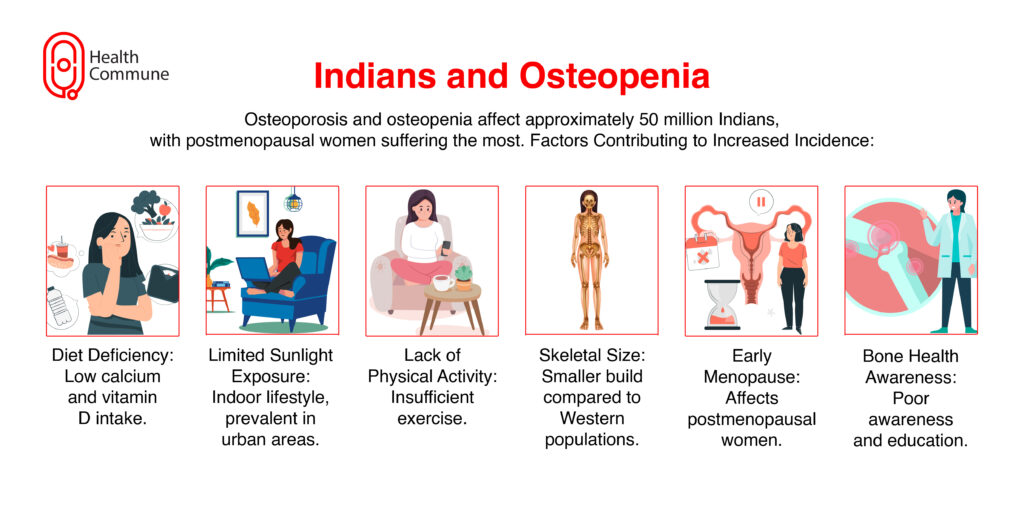Confused between osteoporosis and osteopenia? Learn about the causes, symptoms, complications, and treatment options of osteopenia here.
What is osteopenia?
Osteopenia is when your bones are weaker than normal due to a decrease in your bone mineral density (BMD). (Bone mineral density refers to the amount of calcium and other minerals in your bones.)
This condition is the less severe stage that precedes osteoporosis. In full-blown osteoporosis, bones become extremely weak, brittle, and fracture easily.
What causes osteopenia?
Normal bones are living tissues that undergo constant breakdown and rebuilding. As we grow older, the rate of breakdown is greater than the rate of rebuilding, causing bones to lose their normal structure and strength. This initial stage is called osteopenia. As the process continues, bones continue to become weak and brittle and become prone to fractures from even mild stresses such as sneezing or coughing. This stage is called osteoporosis.
What are the risk factors for osteopenia?
You are more likely to suffer from osteopenia if:
- You’re a woman
- You’re above 50 years of age
- You’ve undergone menopause
- You have poor eating habits with a diet low in vitamin D and calcium
- You have someone in your family with a low BMD, or osteoporosis
- You’re physically inactive or lead a sedentary lifestyle
- You’re suffering from anorexia, bulimia or other eating disorders
- You consume large amounts of alcohol
- You’re a smoker
- You’ve been using corticosteroids for quite some time
- You’ve been on anti-epileptic drugs for a long time
- You’re suffering from medical conditions such as thyroid, parathyroid, or adrenal gland disorders, celiac disease, inflammatory bowel disease, cancer, etc.

Why are Indians more prone to osteopenia?
Osteoporosis and osteopenia affect approximately 50 million Indians, with postmenopausal women suffering the most. A combination of genetic and environmental factors can explain their increased incidence.
These include:
- Diet that is deficient in calcium and vitamin D
- Limited exposure to sunlight due to an increasingly indoor lifestyle, especially amongst the urban population
- Lack of exercise or physical activity
- Smaller build and skeletal size compared to the Western population
- Early menopause
- Poor awareness about bone health
What are the symptoms of osteopenia?
What are the complications of osteopenia?
If you’ve been diagnosed with osteopenia, you have a higher risk of developing osteoporosis. Osteoporosis is commonly accompanied by:
- Lower back pain
- Bent or stooped posture
- Loss of height
- Difficulty in breathing (due to decreased lung capacity)
- Hip discomfort or reduced range of motion
- Fractures
How is osteopenia diagnosed?
Your doctor will take a detailed history, including your medical history, family history and what drugs and medications you’re currently on.
Additionally, they can prescribe a Bone Mineral Density (BMD) test or dual-energy X-ray absorptiometry (DEXA) scan to determine the level of calcium and other minerals in your bones. Based on your score, you can be categorised into:
| DEXA scan score | Category |
|---|---|
| +1 to -1 | Normal |
| -1 to -2.5 | Osteopenia |
| <-2.5 | Osteoporosis |
How is osteopenia treated?
Your doctor will advise you to make simple lifestyle changes, such as:
- Eating a well-balanced, nutritious diet with adequate calcium and vitamin D. Include eggs, milk and other dairy products, fish, leafy green vegetables, etc. in your diet.
- Taking calcium and vitamin D supplements
- Regularly exercising, especially lifting weights
- Sitting under the sun daily for 10-20 minutes between 10 am to 3 pm
- Quitting smoking and drinking
You’ll also be required to periodically undergo DEXA scans to check your bone mineral density (BMD) and monitor the progression of your condition.
What foods are rich in calcium and vitamin D?
Top foods that are rich in calcium and vitamin D include:
- Dairy products like milk, cheese, curd, paneer, buttermilk, etc.
- Fatty fish like salmon, sardines, or tuna
- Eggs
- Spinach
- Oranges
- Soya or tofu
- Ladies finger, okra, or bhindi
- Sesame seeds
Additionally, just sitting under the sun daily for 10-20 minutes between 10 am to 3 pm can naturally increase your vitamin D levels.




